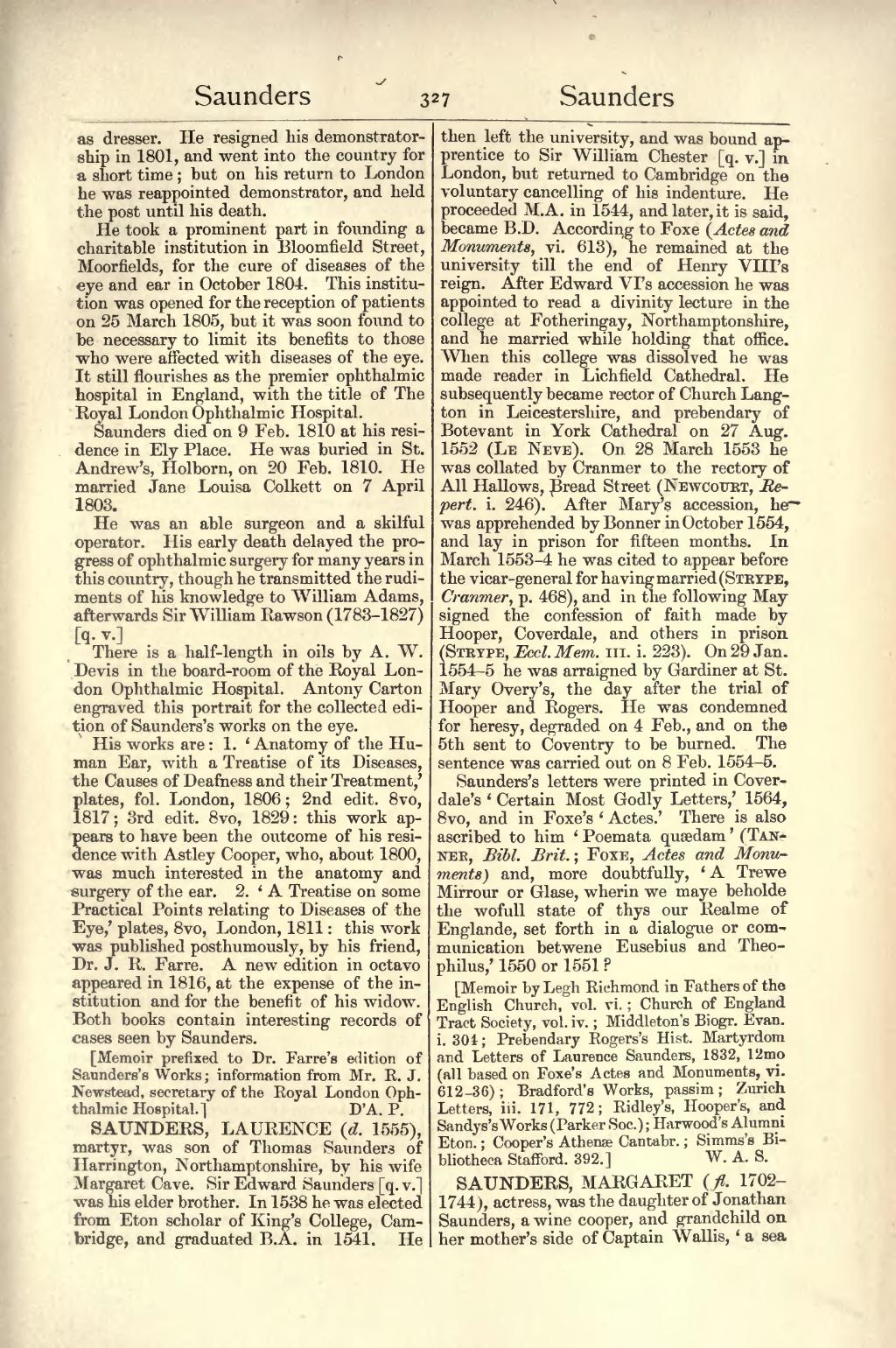as dresser. He resigned his demonstratorship in 1801, and went into the country for a short time; but on his return to London he was reappointed demonstrator, and held the post until his death.
He took a prominent part in founding a charitable institution in Bloomfield Street, Moorfields, for the cure of diseases of the eye and ear in October 1804. This institution was opened for the reception of patients on 25 March 1805, but it was soon found to be necessary to limit its benefits to those who were affected with diseases of the eye. It still flourishes as the premier ophthalmic hospital in England, with the title of The Royal London Ophthalmic Hospital.
Saunders died on 9 Feb. 1810 at his residence in Ely Place. He was buried in St. Andrew's, Holborn, on 20 Feb. 1810. He married Jane Louisa Colkett on 7 April 1803.
He was an able surgeon and a skilful operator. His early death delayed the progress of ophthalmic surgery for many years in this country, though he transmitted the rudiments of his knowledge to William Adams, afterwards Sir William Rawson (1783–1827) [q. v.]
There is a half-length in oils by A. W. Devis in the board-room of the Royal London Ophthalmic Hospital. Antony Carton engraved this portrait for the collected edition of Saunders's works on the eye. His works are: 1. ‘Anatomy of the Human Ear, with a Treatise of its Diseases, the Causes of Deafness and their Treatment,’ plates, fol. London, 1806; 2nd edit. 8vo, 1817; 3rd edit. 8vo, 1829: this work appears to have been the outcome of his residence with Astley Cooper, who, about 1800, was much interested in the anatomy and surgery of the ear. 2. ‘A Treatise on some Practical Points relating to Diseases of the Eye,’ plates, 8vo, London, 1811: this work was published posthumously, by his friend, Dr. J. R. Farre. A new edition in octavo appeared in 1816, at the expense of the institution and for the benefit of his widow. Both books contain interesting records of cases seen by Saunders.
[Memoir prefixed to Dr. Farre's edition of Saunders's Works; information from Mr. R. J. Newstead, secretary of the Royal London Ophthalmic Hospital.]
SAUNDERS, LAURENCE (d. 1555), martyr, was son of Thomas Saunders of Harrington, Northamptonshire, by his wife Margaret Cave. Sir Edward Saunders [q. v.] was his elder brother. In 1538 he was elected from Eton scholar of King's College, Cambridge, and graduated B.A. in 1541. He then left the university, and was bound apprentice to Sir William Chester [q. v.] in London, but returned to Cambridge on the voluntary cancelling of his indenture. He proceeded M.A. in 1544, and later, it is said, became B.D. According to Foxe (Actes and Monuments, vi. 613), he remained at the university till the end of Henry VIII's reign. After Edward VI's accession he was appointed to read a divinity lecture in the college at Fotheringay, Northamptonshire, and he married while holding that office. When this college was dissolved he was made reader in Lichfield Cathedral. He subsequently became rector of Church Langton in Leicestershire, and prebendary of Botevant in York Cathedral on 27 Aug. 1552 (Le Neve). On 28 March 1553 he was collated by Cranmer to the rectory of All Hallows, Bread Street (Newcourt, Repert. i. 246). After Mary's accession, he was apprehended by Bonner in October 1554, and lay in prison for fifteen months. In March 1553–4 he was cited to appear before the vicar-general for having married (Strype, Cranmer, p. 468), and in the following May signed the confession of faith made by Hooper, Coverdale, and others in prison (Strype, Eccl. Mem. III. i. 223). On 29 Jan. 1554–5 he was arraigned by Gardiner at St. Mary Overy's, the day after the trial of Hooper and Rogers. He was condemned for heresy, degraded on 4 Feb., and on the 5th sent to Coventry to be burned. The sentence was carried out on 8 Feb. 1554–5.
Saunders's letters were printed in Coverdale's ‘Certain Most Godly Letters,’ 1564, 8vo, and in Foxe's ‘Actes.’ There is also ascribed to him ‘Poemata quædam’ (Tanner, Bibl. Brit.; Foxe, Actes and Monuments) and, more doubtfully, ‘A Trewe Mirrour or Glase, wherin we maye beholde the wofull state of thys our Realme of Englande, set forth in a dialogue or communication betwene Eusebius and Theophilus,’ 1550 or 1551?
[Memoir by Legh Richmond in Fathers of the English Church, vol. vi.; Church of England Tract Society, vol. iv.; Middleton's Biogr. Evan. i. 304; Prebendary Rogers's Hist. Martyrdom and Letters of Laurence Saunders, 1832, 12mo (all based on Foxe's Actes and Monuments, vi. 612–36); Bradford's Works, passim; Zurich Letters, iii. 171, 772; Ridley's, Hooper's, and Sandys's Works (Parker Soc.); Harwood's Alumni Eton.; Cooper's Athenæ Cantabr.; Simms's Bibliotheca Stafford. 392.]
SAUNDERS, MARGARET (fl. 1702–1744), actress, was the daughter of Jonathan Saunders, a wine cooper, and grandchild on her mother's side of Captain Wallis, ‘a sea
